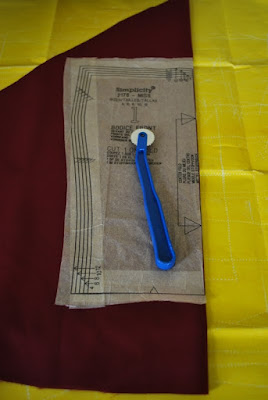Do you make a meticulous tracing of each pattern piece in your size?
I do neither. I don't like to deny any future creations (for different people of different sizes) and I don't have the time to be reproducing full patterns in my size for preservation.
I'm making a little retro number for my first of five dresses for Abakhan Fabrics, I have a master plan for quick tracing but no cutting sizes out of patterns rendering them one-size only pattern pieces.
I cut around the WHOLE of the pattern piece and tape the size lines to improve their integrity. I used a paper tape here.

Taped piece (from the front)
By doing this, I am not cutting into a specific size, thus rendering any bigger and some smaller, useless.

The type of tape that I am referring to.
Used at the back of the pattern piece.
Using carbon paper (the super large 100 x 150 cm Prym carbon paper) and tracing wheel, I create a sandwich of pattern, fabric and carbon paper. Tracing over the reinforced pattern piece like this means that it will stay intact and the tracing marks will be on the back of the fabric.
I then take off the pattern pieces, pinning the fabric in the exact same position. Flip. Use my tracing wheel and paper (underneath the fabric) and go over the traced shapes that I made from my first trace.
This is essentially the Sew Retro Bomshell method, but with tape. If you have taken the course, then you know what I mean... but I thought that it would be good to just show this technique as I love it, you keep the integrity of all the sizes from a pattern, but saves a little time too.
Enjoy! My computer here is refusing to let me upload the whole tutorial pics, so I will upload what I have for now and keep adding to this.
Bundana
X







You are good! I just attack my patterns with the scissors, and hope I never gain/lose weight. X
ReplyDeleteI trace my pattern on to interfacing tracing paper then cut that out. I never cut my paper patterns
ReplyDeleteAm a tracer. My weight fluctuates like no-ones business.
ReplyDeleteBesides I like my patterns intact lol
DeleteI use rolls of greaseproof paper/baking parchment to trace pattern pieces, I can never find my carbon paper!Plus I have a pattern ready to go if I decide to make the same garment twice!
ReplyDeleteI may use this for the bits that aren't bodice! FBA is such a given in my life, as well as broad back that I have to trace the bodice, come what may!
ReplyDeleteYour patience to do this amazes me! I get out the scissors and hack into my patterns with reckless abandon. I've even been known to accidentally cut through an actual piece of the pattern. I have even cut, uncut vintage patterns out. I do have some vintage patterns that I will need to resize before I can use, so I may have to join the dark side of pattern tracers, lol.
ReplyDeleteI always trace onto baking paper. Partly to save my patterns and partly because I can't bear flimsy pattern paper! Although it's the part of the sewing process that I can't wait to get through so I can be guilty of rushing it... I'm liking your method though - might try it next time. x
ReplyDeleteSo the bombshell dress course had a big influence on you! I have to say that it opened my eyes to the awesomeness of carbon paper tracing too. But my big question to you is - WHERE did you get the massive carbon paper from??!!!!!
ReplyDeleteI cut outside the largest size, weigh down the pattern and then place my scissors under the line depicting my size and cut. Works perfectly with transparent patterns. For magazine based patterns I trace of using a double tracing wheel (instant seam allowance!) and carbon paper onto craft paper/ newsprint.
ReplyDeleteI did do a tracing last time i made a skirt, as there was a jacket printed on the back (Prima magazine pattern). I used burda tracing paper, which was good, but after using the tracing wheel a couple times over the same lines it tore through :( so could end up re-tracing if i want to make it again.
ReplyDeleteIn relation to transferring the carbon markings, I had the fabric folded over, right side out, and put the carbon paper in the middle of the folded fabric.
I did have the pattern cut out at this point.
The carbon paper was folded over also; so the carbon faced both wrong sides of the fabric on the inside. With the pattern pinned, if you go over the pattern markings with the wheel (hardish) it will go through both layers of fabric and carbon and transfer the markings to both sides of the fabric at the same time.
You can use this method to mark lining and fabric at the same time too. I do it to try and limit mistakes and misalignments!